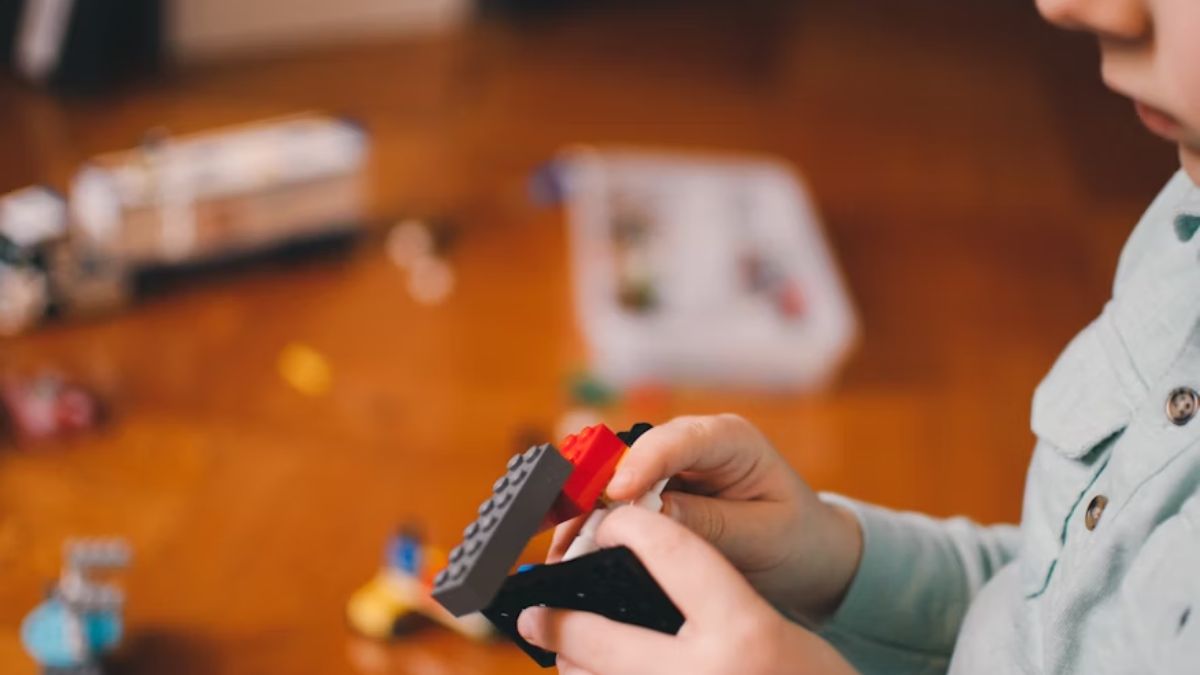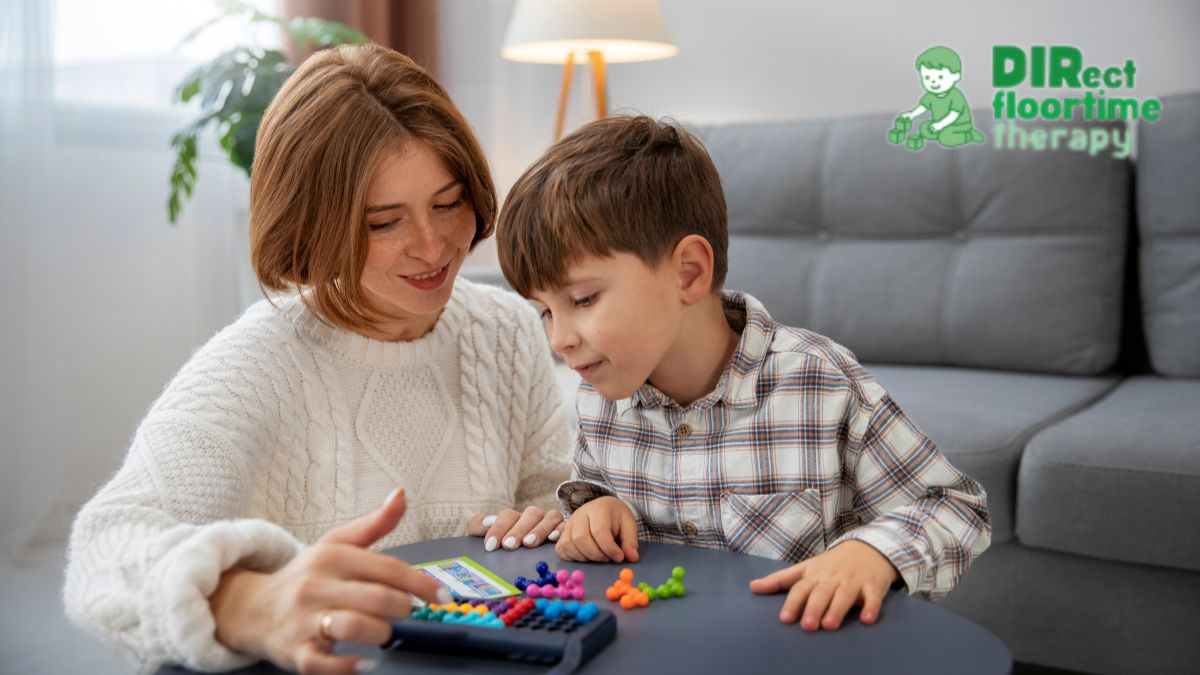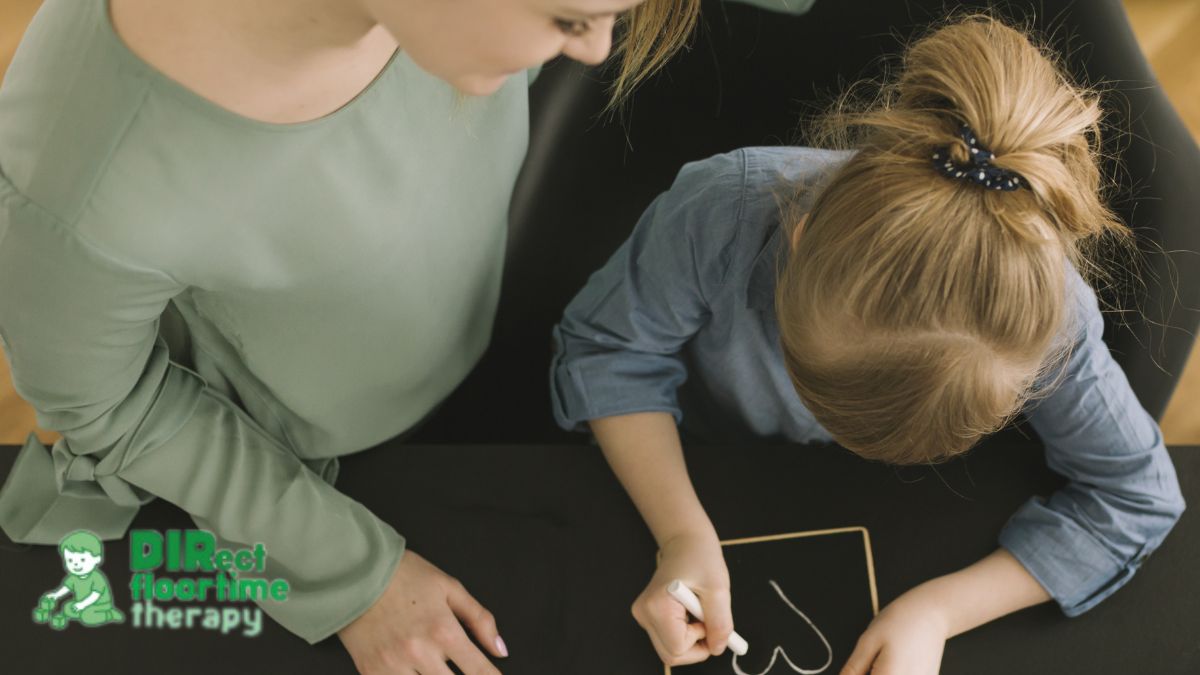Key Points:
- Child-led play builds growth: DIR Floortime follows a child’s lead, turning play into a tool for social, sensory, and emotional development.
- Support for sensory needs: Activities like bubble play, art, and sensory bins help kids process sights, sounds, and textures in a safe way.
- Relationship-focused strategies: Strong parent and therapist connections guide children toward better communication, regulation, and confidence.
Early childhood is a time of rapid brain development, where every experience shapes the way children learn, interact, and understand the world. For children with sensory processing disorder (SPD), everyday sensory inputs can feel overwhelming, confusing, or even uncomfortable. How can we help children navigate these challenges while promoting emotional and cognitive growth? DIR Floortime offers a powerful, child-led solution.
Grounded in decades of research, this approach emphasizes relationship-based engagement and sensory integration to support children’s unique developmental needs. By following the child’s lead and integrating targeted sensory strategies, floortime therapy for autism provides meaningful opportunities for connection, regulation, and learning.
Sensory Processing Disorder Treatments

Sensory processing disorder is a neurological condition that affects how the brain receives, interprets, and responds to sensory information. Children with SPD may overreact to sights, sounds, or textures, or conversely, underreact, seeking intense sensory experiences. To support these children, multiple interventions have proven effective, including DIR Floortime.
Sensory Integration Therapy (SIT): Developed from Dr. A. Jean Ayres’ research in the 1960s, SIT uses structured play and activities to help children respond appropriately to sensory stimuli. Tools such as swings, trampolines, and textured materials are incorporated to improve sensory processing, emotional regulation, and adaptive responses. Studies indicate that SIT can enhance fine motor skills, attention, and social participation in children with developmental challenges.
Sensory-Based Intervention (SBI): SBI focuses on substituting harmful sensory-seeking behaviors with safe, structured sensory activities. Techniques may include massage, weighted blankets, and brushing protocols. Research reviews suggest these interventions can support motor development and self-regulation, particularly in children with cerebral palsy or sensory modulation difficulties.
DIR Floortime: The Developmental, Individual Difference, Relationship-Based (DIR) model incorporates sensory integration into relationship-focused play. Sessions involve following a child’s lead while offering sensory-rich experiences that promote social-emotional growth. Evidence from a 2021 study with 15 children with ASD showed improved social engagement and communication during floortime therapy for autism.
Other complementary approaches, such as therapeutic listening, hippotherapy, and vision therapy, also target sensory integration in specialized ways. However, DIR Floortime distinguishes itself by blending sensory, developmental, and relational strategies in a child-centered framework.
Sensory Processing Disorder Symptoms
Understanding the signs of SPD is essential to providing timely and effective intervention. Children with sensory processing challenges often display a variety of patterns, which can influence behavior, learning, and daily functioning.
Registration Issues: Some children fail to notice sensory stimuli, missing environmental cues and social signals.
Sensation Seeking: Children actively seek heightened sensory experiences, such as spinning, jumping, or tactile exploration.
Sensory Sensitivity: Overreactivity to stimuli may cause distress in noisy, bright, or crowded environments.
Sensation Avoiding: Children may withdraw from sensory input, avoiding certain textures, sounds, or physical contact.
Hyper- and hyposensitivity variations also impact engagement. Hypersensitive children may react strongly to lights or sounds, while hyposensitive children may require intensified sensory input to feel adequately stimulated. These sensory profiles affect not only play and learning but also sleep quality, emotional regulation, and social interaction. DIR Floortime addresses these patterns by customizing activities to match each child’s sensory profile, making learning both safe and enjoyable.
Floortime Approach
DIR Floortime is rooted in developmental psychology and relationship-based interventions, emphasizing emotional engagement and individual differences. The approach is child-led, meaning therapists or educators follow the child’s interests while guiding interactions that foster growth.
Core Principles of DIR/Floortime
Developmental Levels: Recognizes the child’s current stage of cognitive, social, and emotional development.
Individual Differences: Tailors interventions to the child’s sensory needs, motor planning, and learning style.
Relationship-Based Engagement: Uses strong emotional connections to encourage exploration, communication, and self-regulation.
The Role of Play and Sensory Integration

Play is the medium through which DIR Floortime works. Activities like bubble play, building forts, sensory bins, art projects, and musical tasks combine sensory-rich experiences with social and cognitive challenges. By joining the child in play, therapists and parents promote:
Emotional regulation through co-regulation techniques such as deep breathing, gentle touch, or calming sensory tools.
Social engagement by modeling communication, turn-taking, and problem-solving.
Sensory integration by incorporating tactile, auditory, and visual inputs that align with the child’s sensory profile.
This approach ensures that children do not merely endure therapy but actively enjoy learning and discovery, reinforcing essential developmental skills.
Stages of Development in DIR/Floortime
DIR Floortime breaks child development into six stages, each blending sensory input with emotional growth. Following these stages, floortime therapy for autism creates fun, meaningful opportunities for learning.
- Self-Regulation: Kids learn to handle sensory input and adjust to their surroundings. For example, a child using weighted blankets or bubble play can practice calming themselves during overstimulating moments.
- Intimacy and Engagement: Children form close connections through interactive play. Think of building forts together or role-playing, which strengthens trust and social bonds.
- Two-Way Communication: Foundational communication skills emerge as children respond to gestures, sounds, or movement. A simple game of “peek-a-boo” or hand clapping teaches back-and-forth interaction.
- Complex Communication: Imaginative play and advanced social skills grow here. Acting out stories or creating sensory art projects helps children practice problem-solving with peers.
- Emotional Ideas: Children start understanding and expressing complex feelings. Using emotion cards or talking through scenarios can make feelings tangible.
- Emotional & Logical Thinking: Kids integrate sensory, emotional, and thinking skills to support executive function. Activities like planning a small game or sorting tasks help build reasoning and focus.
By guiding activities through these six stages, floortime therapy for autism encourages balanced emotional, cognitive, and sensory growth—making learning enjoyable and effective.
Evidence Supporting DIR Floortime
Research highlights the benefits of floortime therapy for autism and sensory processing disorder:
A systematic review (Divya et al., 2021) reported improvements in emotional functioning, communication, and parent-child interactions for children engaged in home-based DIR Floortime sessions.
Children demonstrated enhanced social engagement, better emotional regulation, and increased ability to navigate sensory-rich environments.
Studies indicate that early, consistent application of DIR Floortime maximizes developmental outcomes, emphasizing the importance of individualized and child-led strategies.
What Happens in a DIR Floortime Therapy Session

DIR Floortime sessions are playful, child-led, and designed to meet each child’s sensory and emotional needs. Every session starts by observing what the child is interested in. Therapists or parents follow the child’s lead, joining their play while adding gentle guidance to encourage learning and growth.
Sensory Bins: Kids explore a variety of textures—rice, beans, sand, or water beads—helping them learn to process touch in a fun, safe way. This tactile play builds focus, fine motor skills, and comfort with different sensations.
Bubble Play: Blowing, chasing, and popping bubbles supports visual tracking, oral motor skills, and self-regulation. Children learn to calm themselves while interacting with dynamic visual and sensory input.
Role-Playing & Fort Building: Acting out scenarios or building forts together sparks imagination and encourages problem-solving. It also teaches emotional understanding, as kids practice expressing feelings, taking turns, and navigating social cues.
Art & Musical Activities: Painting, sculpting, or using musical instruments combines creativity with sensory input. Children practice communication, coordination, and emotional expression in a joyful, hands-on way.
Throughout the session, therapists and parents use co-regulation strategies, like deep breathing, gentle touch, or short sensory breaks. They create a safe, supportive environment, always following the child’s lead. This approach ensures that learning is enjoyable, engaging, and tailored to each child’s sensory profile, helping them grow emotionally, socially, and cognitively.
Integrating DIR/Floortime with Other Therapies
DIR Floortime can complement occupational therapy, speech therapy, and behavioral interventions. Occupational therapists often create sensory diets—personalized sets of activities targeting self-regulation, attention, and sensory modulation—while speech therapists support communication and expressive language development. By integrating these approaches, children benefit from a holistic plan that addresses multiple developmental domains simultaneously.
Emerging innovations include the use of technology, such as apps for communication and sensory engagement, alongside traditional DIR Floortime methods. Multi-disciplinary collaboration ensures that each child’s interventions are coordinated, tailored, and developmentally appropriate.
Who Can Benefit from DIR/Floortime?
DIR Floortime is highly versatile and can support children with:
- Autism Spectrum Disorder (ASD)
- Sensory Processing Disorder (SPD)
- Speech and language delays
- Attention Deficit Hyperactivity Disorder (ADHD)
The approach is particularly effective because it respects individual differences, follows the child’s lead, and integrates sensory, emotional, and cognitive development in a natural, play-based setting.
Helping Your Child Thrive
Sensory processing disorder can make everyday experiences overwhelming, affecting a child’s ability to explore, regulate emotions, and engage with others. DIR Floortime therapy addresses these challenges through relationship-based strategies and sensory-rich, child-led play. Research shows it supports social engagement, communication, and emotional regulation, making a real difference for children with autism and SPD.
By understanding each child’s sensory profile, using co-regulation techniques, and following the developmental stages of DIR Floortime, children enjoy safe, meaningful opportunities to learn and connect. When combined with occupational or speech therapy, this approach offers a well-rounded path for growth in both sensory processing and social-emotional skills.
If you’re in Central Jersey and want to see how DIR Floortime therapy can empower your child, reach out to us today. Let’s work together to help your child navigate the world confidently, creatively, and joyfully.



